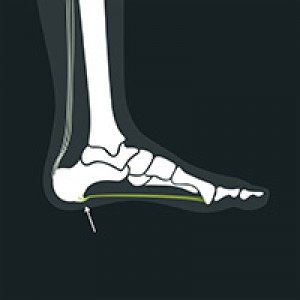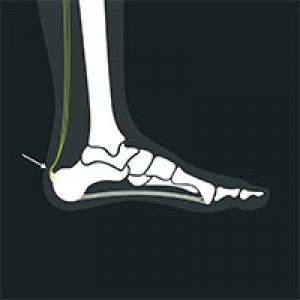HEEL SPUR
Do you get heel pain with every step? You might have a heel spur.
When your foot strikes the ground, you feel like you’ve stepped onto a thumb tack.” That’s how some people describe their heel spur symptoms. Most mornings, you have heel pain when you get up. The pain from a heel spur subsides during the day. That’s because moving relaxes the muscular and fascial tissue in the soles of your feet and your calves. If you fail to act in time, that initially dwindling heel pain can develop into a heel spur. You’ll continually have sharp pain in your heel, and it restricts your daily life.
WHAT IS HEEL A SPUR?
A heel spur is a pointed, bony growth that can develop on your heel bone. Usually, it happens because the tissue running along the sole of your foot (the plantar fascia) becomes irritated. That’s why it is also known as plantar fasciitis. When your Achilles tendon is put under too much strain, it makes this kind of bone growth more likely – in this case, it grows on the upper part (back) of the heel bone. The constant extra strain pulls on the membrane around your bones (periosteum), resulting in bony growths and deposits known as “heel spurs”. Heel spurs are not necessarily visible to the naked eye – they only show up on an X-ray.
There are two types of heel spur:
- Lower heel spur (underside of foot; plantar area): this is a bony protrusion on the underside of the heel. A lower (or inferior) heel spur is caused by too much strain on the plantar fascia.
- Rear heel spur (on back of heel): this is a bony growth where the Achilles tendon attaches to the bone. In this case, you’ll get pain in the back of your heel. A rear (or posterior) heel spur is caused by too much strain on the Achilles tendon.
WHAT ARE THE SYMPTOMS OF A HEEL SPUR?
- You have stabbing pain in your heel when you put weight on it.
- In the mornings, you get pain when you first start moving. You’ll especially notice this for the first few steps you take after getting up.
- The heel pain radiates from your foot to your lower leg.
- The inflammation this causes leads to the heel spur swelling up, and your heel will feel warm.
- You might feel or see a small protrusion on your heel.
- Often, though, a heel spur goes unnoticed because it doesn’t always cause symptoms.
In the past, physicians would usually operate on a heel spur, but this only rarely offered long-term improvements for the pain. Here’s the good news: surgery is only necessary in the rarest of cases. In fact, you can alleviate heel spur pain with the tips provided below.
WHAT CAUSES A HEEL SPUR?
The most common cause of heel spur is excessive or unevenly distributed pressure when walking or running.
- Inflammation of the plantar fascia or, more rarely, of the Achilles tendon, as a cause of heel spurs:
Putting too much pressure on your heels by standing for a long time or doing sport over a longer period can cause unphysiological stresses. You may also get small tears and inflammation in your heel. This is your body’s response as it adapts to the improper stresses and strains. With the increased strain, calcium starts to get deposited in the affected area where the connective tissue attaches to the bone (the enthesis). This is the body’s attempt at making the heel more resilient and restoring its natural tensile characteristics. But it’s not the protruding bone itself that causes the pain. The strong pulling force on the membrane around your bones (periosteum) leads to the discomfort, along with a chronically inflamed plantar fascia in advanced cases. In rarer cases, increased tension and inflammation of the Achilles tendon can also cause heel pain.
- Lack of mobility in the sacroiliac joint (SIJ) as a cause of heel spurs
the sacroiliac joint connects the sacrum to the iliac bone, meaning it connects the back of your pelvic area to your spine. You might be wondering how poor mobility in your pelvis can cause heel problems. It’s quite simple: lack of mobility in the SIJ, which usually affects one side, causes your pelvis to become misaligned. The altered tension along the back myofasciae means that the legs are different lengths. As a result, your weight is unevenly distributed across your feet. On the side where the load is heavier, the calf and foot muscles become overly strained. The heel starts to sit in an unnatural position, stretching the plantar fascia too much and causing inflammation.
DR. TORSTEN PFITZER, HOLISTIC PAIN THERAPIST AND HEALTH COACH:
“In general, the human body is designed for endurance running. Unfortunately, our feet nowadays barely get enough exercise. Rigid footwear and sitting for long periods in everyday life mean we don’t use the muscles and fascia in our foot arches enough. At the same time, we often end up doing too much standing up or sport while we have these imbalances. These extra strains start to cause heel pain and heel spurs.”
WHAT CAN YOU DO IF YOU HAVE A HEEL SPUR?
There are treatments available for heel spurs and heel pain. What’s important is that you restore the natural tensile characteristics of your connective tissue, and strengthen your foot muscles.
- Ease pressure:
in the early stages, what counts is protecting the affected area. Avoid movements that are very demanding on your feet (standing for long periods, jogging, running
and jumping). Ideally, take a break from sports for now.
- Cold or heat therapy:
cooling helps alleviate pain caused by inflammation. Heat helps to loosen up overly strained muscles and fascia. Just give it a try and see what feels best for you.
- Movement:
do a self-massage on your plantar fascia and calf muscles. This can really help with your mobility and ease muscle tension. When doing a fascia massage on the sole
of your foot, remember: roll as close as possible to the heel spur. Only apply light pressure on the painful area. Next, you should mobilize your sacroiliac joint (SIJ).
- Strength along the length of your foot and calf muscles:
activation exercises using stretched positions help alleviate shortening of your foot and calf muscles. This provides a stimulus to regenerate your connective tissue.
- Comfortable footwear:
if you have a tendency to get heel spurs, you should wear comfortable shoes or temporarily wear (gel) insoles to relieve pressure on the area with the heel spur. An
orthopedist can recommend which insole is right for you depending on what kind of misalignment you have in your foot. You shouldn’t use this as a permanent
solution, because it often ends up further reinforcing the misalignment. A better, longer-lasting way is to balance out tension using exercises.
If the pain is more severe and persists even with the exercises, we recommend you visit your doctor. They will be able to prescribe you the right medicine, ointment,
shockwave therapy or radiotherapy, if needed. Even so, you’ll only be able to get rid of the pain for the long term if you change your lifestyle and ease tension in your
muscles and fasciae.
HERE’S HOW YOU CAN PREVENT A HEEL SPUR:
- Choose the right footwear and replace your running shoes as often as you can. Worn shoes, or shoes that are worn very unevenly (the height is different between the
heel and the forefoot) make a heel spur more likely.
- Make sure that the surface you’re running on isn’t too hard.
- Keep an eye on your weight: if you’re overweight, this often puts too much pressure on your heels.
- Run barefoot: slowly start to try out barefoot running. It will help you to avoid landing with your weight on your bones and joints, landing instead on the muscles and
fasciae. This option is especially suited to warmer months, if you’re able to run on different surfaces. Some of the best options include grass, moss and sand.
- Mobilize and activate your foot muscles regularly.
There are no products to list in this category.



